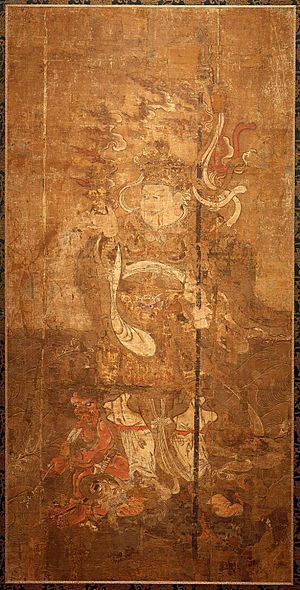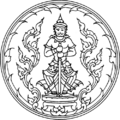Vaisravana facts for kids
Vaiśravaṇa (say "Vy-shrah-vah-nah") is a very important figure in Buddhism. He is known as the leader of the Four Heavenly Kings. These kings are like guardians who protect the world.
Contents
What's in a Name?
The name Vaiśravaṇa comes from a Sanskrit word, viśravaṇa. This word means "Great Fame."
Vaiśravaṇa is also known by another name, Kubera.
Who is Vaiśravaṇa?
Vaiśravaṇa's character is based on the Hindu god Kubera. Even though they share some traits, the Buddhist and Hindu versions have different jobs and stories.
Vaiśravaṇa is often shown with a yellow face. He carries an umbrella, which shows his power and importance. Sometimes, you might see him with a mongoose. This mongoose often spits out jewels! The mongoose is a natural enemy of snakes, which can stand for greed. The jewels he spits out show how generous Vaiśravaṇa is.
Vaiśravaṇa in Theravāda Buddhism
In the Pāli writings of the Theravāda Buddhist tradition, Vaiśravaṇa is called Vessavaṇa. Vessavaṇa is one of the Four Great Kings. Each of these kings rules over one direction of the world. Vessavaṇa's special direction is the north.
Vessavaṇa got the name "Kuvera" from a past life. He was once a rich mill-owner. He gave all the money from one of his seven mills to help people in need. He helped the poor for 20,000 years!
In Buddhism, Vessavaṇa is not just one person forever. It's more like a title. When one Vessavaṇa passes away, a new person takes on the role. These beings live for a very long time, sometimes said to be 90,000 years or even millions of years.
When the Buddha was born, Vessavaṇa became one of his followers. He often brought messages to the Buddha and his followers from gods and other people. He also helped protect them.
Vaiśravaṇa in Japan
In Japan, Vaiśravaṇa is known as Bishamonten (say "Bee-shah-mon-ten") or just Bishamon. Here, he is seen as a god of war and warriors. He wears armor and punishes those who do bad things. This idea is a bit different from the peaceful king described earlier.
Bishamon is shown holding a spear in one hand. In his other hand, he holds a small pagoda. This pagoda is a symbol of a special treasure house. It holds the valuable things he guards and gives away. In Japanese stories, Bishamon is one of the Japanese Seven Lucky Gods.
Vaiśravaṇa in Tibet
In Tibet, Vaiśravaṇa is known as a protector of the Dharma, which means the teachings of Buddhism. He is also called the King of the North. Because he guards the north, you often see his picture on temple walls near the main door. He is also known as a god of wealth.
Sometimes, Vaiśravaṇa is shown holding a citron fruit. This fruit comes from the jambhara tree. This helps people tell him apart from other pictures of Kuvera.
Vaiśravaṇa in Popular Culture
- In the Playstation 2 game Samurai Warriors, a character named "Uesugi Kenshin" often prays to Bishamon for strength. He even gets the title "Bishamonten Avatar."
- In the video game series Onimusha: Warlords, you can see a Bishamon statue. The Bishamon Sword is also the most powerful weapon in the game.
- In Atlus's video game series Megami Tensei, Bishamon is part of the Kishin group. This group includes protectors of different things.
- In the PC game Touhou: Unidentified Fantastic Object, a character named Shou is a tiger spirit. She is called the "Disciple of Vaiśravaṇa" because she is like the human form of Bishamonten. Her music theme is even called "The Tiger Patterned Vaisravana."
See also
 In Spanish: Vaisravana para niños
In Spanish: Vaisravana para niños
- Four Heavenly Kings
- Seven Lucky Gods
Images for kids





